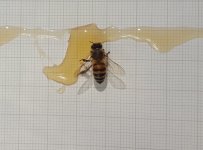Hi, I'm Derek Mitchell a researcher in the UK at the University of Leeds, looking into the heat transfer of honey bees ( I have several papers published see below.) My problem is that the dimensions of honeybees that I need, are not available.
I need to measure living bees and find their length and average diameter The size of honey bees is very important in understanding how they can withstand heat and cold inside their nests [1] I ideally i would like to find this for all subspecies around the world, but I need to start somewhere. Why start in NZ? Your bees are accessible in December . So please can you help me?
What do I need?
What I need is a picture of one or just few of your bees while they are sitting on squared paper (graph paper is good) ,eating honey. It shouldnt be too difficult to persuade them to that . IMPORTANT place a rule somewhere in the picture on the squared paper so I know how big the squares are on the paper. Take the photograph with camera directly over the bee from at least 300mm (12") above. Then email me the photograph at derek@eigentek.com with rough location of the bee . I dont need precise location just enough to get climatic data e.g the nearest town. I know beehive security is a big thing in NZ. Note I'm not using my university email as I dont want to run into their email limits.
. IMPORTANT place a rule somewhere in the picture on the squared paper so I know how big the squares are on the paper. Take the photograph with camera directly over the bee from at least 300mm (12") above. Then email me the photograph at derek@eigentek.com with rough location of the bee . I dont need precise location just enough to get climatic data e.g the nearest town. I know beehive security is a big thing in NZ. Note I'm not using my university email as I dont want to run into their email limits.
Here is an example with a bee out of my garden. but REMEMBER place a Rule in the picture, unlike this one. IF you run into problems please email me at the above address I might need to refine my instructions
[1] D. Mitchell, “Honey bee ( Apis mellifera ) size determines colony heat transfer when brood covering or distributed,” Int. J. Biometeorol., vol. Accepted, 2022.
[2] D. Mitchell, “Ratios of colony mass to thermal conductance of tree and man-made nest enclosures of Apis mellifera: implications for survival, clustering, humidity regulation and Varroa destructor,” Int. J. Biometeorol., vol. 60, no. 5, pp. 629–638, 2016.
[3] D. Mitchell, “Thermal efficiency extends distance and variety for honeybee foragers: Analysis of the energetics of nectar collection and desiccation by Apis mellifera,” J. R. Soc. Interface, vol. 16, no. 150, 2019.
[4] D. Mitchell, “Nectar, humidity, honey bees (Apis mellifera) and varroa in summer: A theoretical thermofluid analysis of the fate of water vapour from honey ripening and its implications on the control of Varroa destructor,” J. R. Soc. Interface, vol. 16, no. 156, 2019.
[5] D. Mitchell, “Honey bee engineering: Top ventilation and top entrances,” Am. Bee J., vol. 157, no. 8, pp. 887–889, 2017.
I need to measure living bees and find their length and average diameter The size of honey bees is very important in understanding how they can withstand heat and cold inside their nests [1] I ideally i would like to find this for all subspecies around the world, but I need to start somewhere. Why start in NZ? Your bees are accessible in December . So please can you help me?
What do I need?
What I need is a picture of one or just few of your bees while they are sitting on squared paper (graph paper is good) ,eating honey. It shouldnt be too difficult to persuade them to that
Here is an example with a bee out of my garden. but REMEMBER place a Rule in the picture, unlike this one. IF you run into problems please email me at the above address I might need to refine my instructions

[1] D. Mitchell, “Honey bee ( Apis mellifera ) size determines colony heat transfer when brood covering or distributed,” Int. J. Biometeorol., vol. Accepted, 2022.
[2] D. Mitchell, “Ratios of colony mass to thermal conductance of tree and man-made nest enclosures of Apis mellifera: implications for survival, clustering, humidity regulation and Varroa destructor,” Int. J. Biometeorol., vol. 60, no. 5, pp. 629–638, 2016.
[3] D. Mitchell, “Thermal efficiency extends distance and variety for honeybee foragers: Analysis of the energetics of nectar collection and desiccation by Apis mellifera,” J. R. Soc. Interface, vol. 16, no. 150, 2019.
[4] D. Mitchell, “Nectar, humidity, honey bees (Apis mellifera) and varroa in summer: A theoretical thermofluid analysis of the fate of water vapour from honey ripening and its implications on the control of Varroa destructor,” J. R. Soc. Interface, vol. 16, no. 156, 2019.
[5] D. Mitchell, “Honey bee engineering: Top ventilation and top entrances,” Am. Bee J., vol. 157, no. 8, pp. 887–889, 2017.

